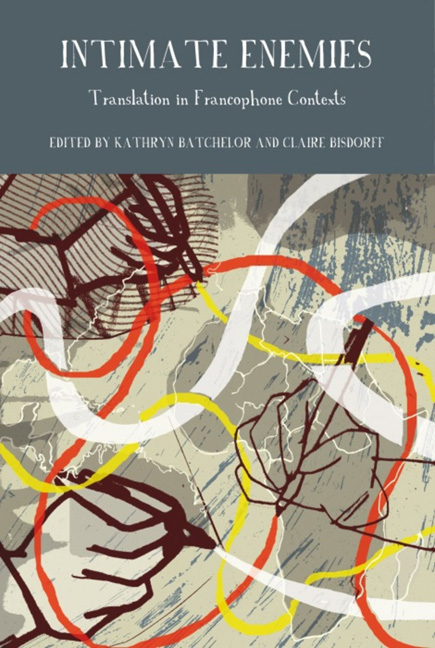Book contents
- Frontmatter
- Contents
- Illustration
- Acknowledgements
- Introduction: Translation – Formidable Enemy or Needed Friend?
- The Translation Market: Publishing and Distribution
- Writing and Translating in Practice
- Translation Challenges and New Avenues in Postcolonial Translation Theory
- Subverting Subversion? Translation Practice and Malpractice in the Work of Patrick Chamoiseau
- ‘Un art de la fugue’: Translating Glissant's Poetry, Fiction and Prose d'idées
- Postcolonial Intertextuality and Translation Explored through the Work of Alain Mabanckou
- Ananda Devi as Transcolonial Translator
- Translation and Current Trends in African Metropolitan Literature
- Notes on Contributors
- Index
Subverting Subversion? Translation Practice and Malpractice in the Work of Patrick Chamoiseau
from Translation Challenges and New Avenues in Postcolonial Translation Theory
- Frontmatter
- Contents
- Illustration
- Acknowledgements
- Introduction: Translation – Formidable Enemy or Needed Friend?
- The Translation Market: Publishing and Distribution
- Writing and Translating in Practice
- Translation Challenges and New Avenues in Postcolonial Translation Theory
- Subverting Subversion? Translation Practice and Malpractice in the Work of Patrick Chamoiseau
- ‘Un art de la fugue’: Translating Glissant's Poetry, Fiction and Prose d'idées
- Postcolonial Intertextuality and Translation Explored through the Work of Alain Mabanckou
- Ananda Devi as Transcolonial Translator
- Translation and Current Trends in African Metropolitan Literature
- Notes on Contributors
- Index
Summary
Patrick Chamoiseau's idiosyncratic storytelling, as well as his involvement in the Créolité movement, has led to a significant body of research which addresses his novels and his critical engagement, yet there has been much less scholarly attention given to his work in translation. This is somewhat surprising, given that what is most striking about Chamoiseau's work is his extraordinary foregrounding of language which each of his successive translators has tackled: after all, ‘nowhere in the body of postcolonial literature is the question of language so fraught, so endlessly and acutely theorized as Martinique’ (Munro, 2005: 1103). Indeed, there is a consensus that its translators walk ‘a tightrope’, while the translation of Chamoiseau in particular is judged ‘a potential nightmare for the translator’ (N'Zengou-Tayo and Wilson, 2000: 79). Chamoiseau's eclectic play between Creole and French, his code-switches between Creole and an almost simultaneously standard, archaic and non-standard French, his register and sociolectal shifts, juxtapositions and non-standard syntax, neologisms, creolisms, onomatopoeia and more, all serve to create a hybridized ‘français chamoisisé’ (Kundera, 1991: 50–61) which appears to resist translation. While this interstitial language represents a specific challenge for the translator, Chamoiseau's chaos-poésie plays a highly significant functional role, explicitly underpinning a subversive, deflective logic of opposition which is fundamental to the coherence of his work. As a result, the linguistic choices of these source and target texts are even more intensely foregrounded in this translation context than is usual in the already language-obsessed translation world, and bring into sharp relief the possibilities and limitations of translating a literature which is, in itself, a radical interrogation of language and culture.
This is certainly the case for the contes créoles of Chamoiseau's Au temps de l'antan: contes du pays Martinique (1988a) (hereafter TA). Translated by Linda Coverdale as Creole Folktales (1994) (hereafter CF), this collection of Antillean tales represents, in some ways, the epitome of the Creolist tendency towards the multivalent, blurring the generic boundaries between myth, fable, folktale and literary fairytale, and embodying the ultimate synthesis of the oral and the written which characterizes the Creolist vision of ‘oraliture’ (Chamoiseau and Confiant, 1991: 73). More significantly, Au temps de l'antan's counter-poetics encapsulate the tensions and oppositional logic at work in Chamoiseau's narratives and, as such, make this work a crucial subject of study in translation.
- Type
- Chapter
- Information
- Intimate EnemiesTranslation in Francophone Contexts, pp. 161 - 180Publisher: Liverpool University PressPrint publication year: 2013

